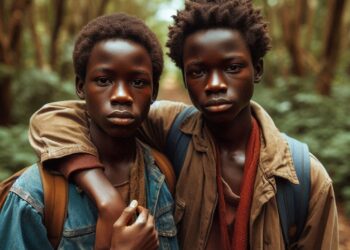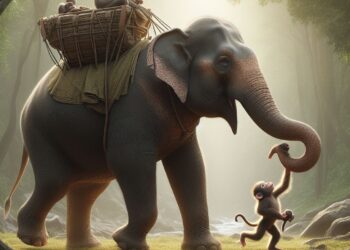Long ago in the Kingdom of Buganda, lived a wise and kind man named Kintu. He had a special and loyal companion, a cow that he moved with through thick and thin. In the Kingdom of Buganda where everything was magical and nature flourished, stories of Kintu’s kindness and wisdom echoed through the valleys.
One sunny day, a divine twist of fate brought Kintu face to face with the gods themselves. Ggulu, the mighty creator of all things, resided high above in the heavens, surrounded by his heavenly family. During an earthly visit, Nambi, Ggulu’s daughter, and some of her playful and stubborn brothers stumbled upon Kintu in Buganda. Nambi, captivated by Kintu’s humble presence, felt a strong connection and decided she wanted to marry him and live on Earth. This wasn’t as easy as picking flowers in a field. Nambi’s brothers weren’t happy about her decision, but her determination won them over eventually, and Nambi and Kintu set off to seek Ggulu’s blessing for their union and new life on Earth.
While Ggulu was quite doubtful about his daughter marrying a human and living on Earth, after much pleading from Nambi, he finally agreed but gave them a strong warning. They had to leave heaven secretly, taking only a few belongings, and, under no circumstances, were they to return, or else they’d face the wrath of Walumbe, Nambi’s troublesome brother who brought sickness and death wherever he went.
Excited to start their new life, Kintu and Nambi followed Ggulu’s instructions. As they descended to Earth, Nambi suddenly remembered she had left her chicken’s millet behind. Ignoring Kintu’s warnings, she decided to go back and fetch it. Little did she know that this decision would change everything. During her return, Nambi crossed paths with Walumbe, who questioned her about her journey. Caught off guard, Nambi revealed her plan to marry Kintu and live on Earth. This infuriated Walumbe, who swore that he would cause mischief in their lives. Nonetheless, Nambi was filled with so much enthusiasm and she continued on her journey to meet Kintu, with whom they would start their life on earth.
On Earth, life went on well for Kintu and Nambi, who soon had children. One day, Walumbe visited Kintu’s home and demanded a child to help him with chores. Doubtful of Walumbe’s intentions, Kintu refused and a heated argument ensued. In a fit of rage, Walumbe killed Kintu’s son, causing a huge rift between them.
In a bid to seek justice, Kintu journeyed to heaven to report Walumbe’s actions to Ggulu. However, Ggulu reminded Kintu of the warning he and Nambi had ignored and shifted the blame to Nambi for her return. Determined to rectify the situation, however, Ggulu sent Kayikuuzi, another son, to convince Walumbe to return to heaven. On reaching Earth, Kayikuuzi urged Walumbe to return to heaven, but Walumbe, stubborn as ever, refused. Kayikuuzi decided to capture Walumbe by force, leading to a fierce fight that saw Walumbe disappear into the ground where he sought refuge. Kayikuuzi followed him in a chase underground.
After days of a pursuit that saw Kayikuuzi dig tunnels into the ground to find his brother, Kayikuuzi, nearing exhaustion, approached Kintu and Nambi with a plan. They were to remain indoors, and their children were not to utter a sound if they saw Walumbe. Kayikuuzi believed he could capture Walumbe secretly. Kintu and Nambi followed the instructions, but some children remained outdoors. As the final confrontation occurred, the children outside screamed in terror at the sight of Walumbe. Startled, Walumbe vanished into the ground again, leaving Kayikuuzi furious.
Disappointed by Kintu and Nambi’s failure to follow instructions, Kayikuuzi decided to cease the struggle. Before leaving, he advised Kintu to have more children, as the more offspring he had, the harder it would be for Walumbe to harm them all.
And so, the Place of Death, Ttanda, became a symbol of the epic battle between life and death, where Kayikuuzi’s pursuit of Walumbe left behind a network of mysterious underground passages. The very creation of the modern-day mythical caves at Ttanda in Ssingo is attributed to this fierce pursuit, and the name Kayikuuzi signifies the one who digs holes.
Moral of the story: sometimes, disobedience can lead to unforeseen consequences, and it’s essential to follow wise counsel. The courage and determination of Kintu and Nambi, along with the mysterious adventures with gods and celestial battles, make this Buganda myth an enchanting tale for children, filled with lessons about choices, consequences, and the enduring strength of family.















